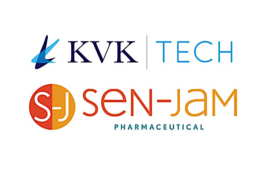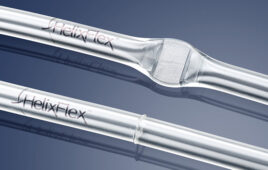Aside from no moving parts in grinding mill proper, there is another inherent advantage in operating a jet mill with ambient air. Unlike mechanical mills, no heat is generated. This is due to the Joule-Thomson cooling effect. A gas under pressure will show a drop in temperature once it exits a nozzle. By way of example, a Carbon Dioxide (CO2) fire extinguisher under ~200 psig will show an exit temperature of ~-66°C (-87°F) cooling effect under ambient conditions. This can be beneficial in jet-milling organic heat sensitive materials such as waxes, pharmaceuticals, and food additives—to name but a few.
In addition to jet mill’s primary function of converting relative coarse sand-like size incoming particles to low- and sub-micron sizes, other unit operations can be included and carried out simultaneously. Some of these include continuous dynamic blending of two or more materials. Given the turbulent circulating velocities in some jet mills as high as 500 ft./sec., not only is a uniform blend achieved but in some cases, the “softer” component is penetrated by the more brittle one(s).
Another operation is drying. While material is only exposed to temperatures as high as ~700°F for a few seconds at best, instantaneous flashing off of free moisture occurs due to particle separation in the turbulent air steam. Further process operations include: beneficiation, coatings, and chemical reactions between two or more materials. All these can occur in seconds or less due to the highly-exposed surface area of the circulating load in the mill.
To understand the importance surface area plays in chemical reactions, consider this. Hold a blowtorch to the top of a tied up bundle of new paper. Once the blowtorch is removed any residual flame goes out—no surface area. Now make a crumpled pyramid pile of the individual papers then touch a match to the bottom of the pile and within seconds, it immediately becomes a roaring bonfire. This is due to the tremendous amount of combustible surface area exposed to air (oxygen) and heat. The same reaction can and does occur in grain silos when the very fine dust is exposed to even a static spark under the right conditions.
With the recognition and better understanding of how a particle significantly reduced in size to low microns can be used to develop new products, a whole new product frontier is emerging. While jet mills could and have always produced low and submicron particles from the beginning, product specifications back in the fifties, sixties, and seventies often only called for a finished product 99.9 percent less than 325 mesh or 43 micron. The reason why was simply the lack of analytical instrumentation which can now be used regularly in QC to measure and assure a consistent finished product today.
Before embarking on any size reduction operation, it is important that material properties, such as moisture content, friability, abrasiveness, elasticity, and more be thoroughly understood so as to be able to more accurately evaluate their impact on a final micronized product.
Follow us on Twitter and Facebook for updates on the latest pharmaceutical and biopharmaceutical manufacturing news!




